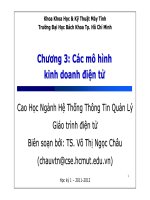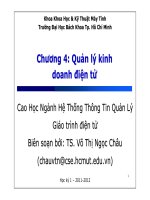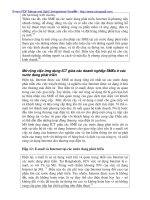Quản lý kinh doanh điện tử
Bạn đang xem bản rút gọn của tài liệu. Xem và tải ngay bản đầy đủ của tài liệu tại đây (1.52 MB, 89 trang )
1
1
Ch
Ch
ươ
ươ
ng 4:
ng 4:
Quản
Quản
lý
lý
kinh
kinh
doanh
doanh
đ
đ
iện
iện
tử
tử
Học kỳ 1 – 2011-2012
Khoa
Khoa
Khoa
Khoa
Học & Kỹ Thuật Máy Tính
Học & Kỹ Thuật Máy Tính
Tr
Tr
ư
ư
ờng Đại Học Bách Khoa Tp. Hồ Chí Minh
ờng Đại Học Bách Khoa Tp. Hồ Chí Minh
Cao
Cao
Học
Học
Ngành
Ngành
Hệ
Hệ
Thống
Thống
Thông
Thông
Tin
Tin
Quản
Quản
Lý
Lý
Giáo
Giáo
trình
trình
đ
đ
iện
iện
tử
tử
Biên
Biên
soạn
soạn
bởi
bởi
: TS.
: TS.
Võ
Võ
Thị
Thị
Ngọc
Ngọc
Châu
Châu
(
(
)
)
2
2
Tài liệuthamkhảo
[1] In Lee, “Electronic Business: Concepts, Methodologies, Tools, and Applications”,
Idea Group Inc (IGI), 2008.
[2] Sanjiv Purba, “Architectures for E-Business Systems: Building the Foundation
for Tomorrow’s Success”, Auerbach Publications, 2002.
[3] Michael J. Shaw, “e-Business Management: State-of-the-Art Research,
Management Strategy, and Best Practices”, Kluwer Academic Publishers, 2002.
[4] W. S. Whyte, “Enabling eBusiness: Integrating Techologies, Architectures and
Applications”, John Wiley & Sons Ltd, 2001.
[5] Anne König, “E-Business@Print: Internet-Based Services and Processes”,
Springer-Verlag, 2005.
[6] Petter Gottschalk, “E-Business Strategy, Sourcing and Governance”,
Idea Group Inc (IGI), 2006.
[7] Winfried Lamersdorf, Volker Tschammer, Stéphane Amarger, “Building the E-
Service Society: E-Commerce, E-Business, and E-Government“, Kluwer Academic
Publishers, 2004.
[8] Janice Burn, Peter Marshall, Martin Barnett, “e-Business Strategies for
Virtual Organizations”, Elsevier Butterworth-Heinemann, 2002.
[9] Stuart Barnes, “E-Commerce and V-Business: Digital Enterprise in the Twenty-
First Century”, Second Edition, Elsevier, 2007.
[10] Colin Combe, “Introduction to e-Business: Management and Strategy”,
Elsevier, 2006.
[11] Nan Si Shi, V.K. Murthy, “Architectural Issues of Web−Enabled Electronic
Business”, Idea Group Publishing, 2003.
[12] In Lee, “Electronic Business: Concepts, Methodologies, Tools, and
Applications”, IGI Global, 2009.
3
3
Nộidung
Chương 1: Tổng quan về hệ kinh doanh điệntử
Chương 2: Các chiếnlượckinhdoanhđiệntử
Chương 3: Các mô hình kinh doanh điệntử
Chương 4: Quảnlýkinhdoanhđiệntử
Chương 5: Dịch vụ hạ tầng cho các hệ kinh
doanh điệntử
Chương 6: Phát triểnhệ kinh doanh điệntử
Chương 7: Các vấn đề nghiên cứutrongcáchệ
kinh doanh điệntử
Chương 8: Ôn tập
4
4
Chương 4: Quảnlýkinhdoanhđiệntử
4.1. Web và ảnh hưởng củaWeb
4.2. Vấn đề điềuphốivàchiasẻ thông tin trong các qui
trình nghiệpvụ và các chứcnăng nghiệpvụở mứctổ
chức
4.3. Vấn đề thiếtkế tổ chức
4.4. Việcquảnlýđakênh
4.5. Kinh doanh điệntử: từ chuỗi cung cấp đếnWeb cung
cấp
4.6. Thương mại điệntử B2B
4.7. Vấn đề đánh giá kinh doanh điệntử
4.8. Vấn đề thương mại
4.9. Tóm tắt
5
5
Môi trường
kinh doanh
Figure 1.2. Key differences
between the old and new
economy
[10], pp. 4.
6
6
4.1. Web và ảnh hưởng củaWeb
Lịch sử của Internet [Wikipedia]
Mạng lớnnhấtkếtnối các mạng (network) trên
thế giới
Network of networks
Liên kếtcácmáytínhtừ cá nhân đếncôngcộng (trường
học, chính phủ), …
Cung cấpcơ sở hạ tầng cho việcsử dụng emails, bảng
thông báo, lưutrữ files, siêu vănbản, cơ sở dữ liệuvà
các tài nguyên tính toán khác
Sử dụng giao thức TCP/IP và dạng chuyểnmạch gói
(packet switching)
7
7
4.1. Web và ảnh hưởng củaWeb
Lịch sử của Internet [Wikipedia]
1962 – computer research program
Leaded by John Licklider (MIT)
“Galactic Network” concept Æ kết nối các máy tính lại với nhau.
Lý thuyết chuyển mạch gói (packet switching) -Leonard
Kleinrock
1965 – first “wide area network” (WAN)
Kết nối giữa Berkeley và MIT
1967 – plans for ARPANET (Advanced Research Projects
Agency Net)
MIT – NPL (National Physics Lab - UK) – RAND corporation
1969 – Interface Message Processor (IMP) - BBN (
Bolt,
Beranek & Newman)
4 computers (UCLA, SRI, UCSB and UTAH)
8
8
4.1. Web và ảnh hưởng củaWeb
Lịch sử của Internet [Wikipedia]
1971 – 23 host computers (15 nodes)
1972 – ARPANET trở thành mạng công cộng
ICCC (International Conf. on Computers and
Communication – Washington DC, USA)
Email: chương trình đầu tiên cho dạng giao tiếp person-
to-person
1973
75% sử dụng ARPANET cho e-mail
Kết nối quốc tế đầu tiên - University College of London
9
9
4.1. Web và ảnh hưởng củaWeb
Lịch sử của Internet [Wikipedia]
1974 – TCP/IP (Transmission Control Protocol/Internet Protocol)
Mỗimạng tồntạivàvậnhànhriêng.
Mỗimạng có 1 cổng ra vào (‘gateway’).
Các gói đitrongmạng/giữamạng được định hướng theo đường chuyển
nhanh nhấtcósẵn.
1974/1982 – Networks đượctriểnkhai
Telenet – Phiên bảnthương mại đầutiêncủaARPANET
MFENet –Magnetic Fusion Energy
HEPNet –High Energy Physics
SPAN – space physicists
Usenet – Hệ thống mở cho email và newsgroups
Bitnet – Sự thịnh hành củamáyIBM ở các trường đạihọc
CSNet – Mạng cho Computer Scientists ở universities, industry and
government
Eunet – European version của Unix network
EARN – European version củaBitnet
10
10
4.1. Web và ảnh hưởng củaWeb
Lịch sử của Internet [Wikipedia]
1974/1982
Thờikỳ hỗnloạncủalịch sử phát triểncủa Internet
Nhiềukỹ thuật/giao thứckhácnhaurađờivàcạnh tranh
nhau
1982 – Internet ra đờivớichuẩngiaothứcTCP/IP
1984 – DNS (Domain Name System)
Mỗi máy tính trên mạng được gán tên.
Các tên miền ra đời: edu, com, gov, org, ..., và mã nước
(vn, jp, sg, fr, at, nl, ... - ngoại trừ USA)
1990 – ARPANET ra đi.
11
11
4.1. Web và ảnh hưởng củaWeb
12
12
4.1. Web và ảnh hưởng củaWeb
Figure 1.4. UK Internet users’ online activities (%). Source: Oxis (Sample of 2200)
[10], pp. 9.
13
13
4.1. Web và ảnh hưởng củaWeb
Figure 1.3. Advantages of using the Internet for firms and consumers
[10], pp. 7.
14
14
4.1. Web và ảnh hưởng củaWeb
Lịch sử của World Wide Web [Wikipedia]
Web: hệ thống gồmcácsiêuvănbản liên kếtvớinhautrên
Internet
1989 – World Wide Web (WWW) - Tim Berners-Lee
Scientist at CERN (European centre for High Energy Physics –
Geneva)
Hypertext Markup Language (HTML)
Hypertext Transfer Protocol (HTTP)
Universal Resource Locator (URL)
1990 – browser/editor program đầutiên
The first web server:
15
15
4.1. Web và ảnh hưởng củaWeb
World First Browser và Web page.
16
16
4.1. Web và ảnh hưởng củaWeb
Lịch sử của World Wide Web [Wikipedia]
1993 – trình duyệtWeb rađời
Mosaic web browser: led by Marc Andreeson, the National
Center for Supercomputing Applications (NCSA), the University
of Illinois at Urbana-Champaign (UIUC)
Cello web browser (the first Microsoft Windows): by Thomas R.
Bruce, the Legal Information Institute at Cornell Law School
1994 – Hotmail (Web mail)
Mosaic browser phát triểnthương mại thành Netscape
(Netscape Navigator) web browser
1994 – World Wide Web Consortium (W3C – www.w3.org)
1995 – JAVA source code
1996 – ICQ của Mirabilis (Israel)
1998 – Google (Web search)
Microsoft acquires Hotmail.
AOL acquires Mirabilis and Netscape.
17
17
4.1. Web và ảnh hưởng củaWeb
The Web as a new channel
product distribution, marketing, and interaction
with customers
The Web as the enabler for enterprise
integration
Web infrastructure supported by the Internet
Intranets for supporting intra-organizational
business processes
Extranets for connecting enterprises to their
channel partners
The Internet for linking the enterprises to their
customers, other institutions, and agencies
[3], Chapter 1.
18
18
4.1. Web và ảnh hưởng củaWeb
The
Web
Web provides a new paradigm for supporting
enterprise and supply-chain processes.
Enterprises share product, manufacturing, and customer
information with their partners.
Their suppliers adopt parts of their business processes and
systems to enhance coordination.
Æ Enterprise systems
: portability, inter-operability, plug-and-
play functionalities
The major impact of the
Web
Web on coordinating e-
businesses, in terms of forcing change in business
models, will be the sharing not only of information,
but also knowledge and decision processes.
[3], Chapter 1.
19
19
4.2. Vấn đề điềuphốivàchiasẻ thông tin trong các
qui trình nghiệpvụ và các chứcnăng nghiệpvụở
mứctổ chức
Vấn đề chia sẻ thông tin (information sharing)
Information sharing has been used not only for
reducing the uncertainties and smoothing out
supply chains
, but also for eliminating wasteful
activities, efforts, and resources along the supply
chains.
Wal-Mart: suppliers must study the giant’s weekly sales
figures, forecast demands for their products, and place
them on the shelf.
information-sharing has gone beyond simply
providing some type of data. It may involve a plan
of action based on the data. This kind of
partnership has proven to be mutually beneficial.
20
20
4.2. Vấn đề điềuphốivàchiasẻ thông tin trong các
qui trình nghiệpvụ và các chứcnăng nghiệpvụở
mứctổ chức
Vấn đề chia sẻ thông tin (information
sharing)
Dữ liệu(Data)
Thông tin (Information)
Tri thức (Knowledge)
Æ Khái niệmcótínhtương đối
21
21
4.2. Vấn đề điềuphốivàchiasẻ thông tin trong các
qui trình nghiệpvụ và các chứcnăng nghiệpvụở
mứctổ chức
Vấn đề chia sẻ thông tin (information
sharing)
Chia sẻ tri thức (knowledge sharing)
Quảnlýtri thức (knowledge management)
Quảnlýrủi ro (risk management)
[6], pp. 184-187, 201-207.
22
22
4.2. Vấn đề điềuphốivàchiasẻ thông tin trong các
qui trình nghiệpvụ và các chứcnăng nghiệpvụở
mứctổ chức
Knowledge management (sharing)
For many modern organisations, the route to
competitive advantage
competitive advantage lies in their ability to share
knowledge and become a learning organisation.
Firms need to have
creativity and innovation
creativity and innovation at
the heart of their organisational culture that helps
create a constant stream of new knowledge,
disseminates that knowledge throughout the
organisation and uses it to create new and
differentiated products that add value for
customers.
This is especially cogent in the new economy where
technological obsolescence, rapid change and market
volatility are some of the key industry characteristics.
23
23
4.2. Vấn đề điềuphốivàchiasẻ thông tin trong các
qui trình nghiệpvụ và các chứcnăng nghiệpvụở
mứctổ chức
Different types of knowledge
Explicit knowledge
Explicit knowledge: information stored as data or documents
Tacit knowledge
Tacit knowledge: information stored in the human mind,
‘know-how’, intangible assets such as intellectual and
creative abilities
Theoretical knowledge
Theoretical knowledge: knowledge that furthers
understanding, ‘know-why’
Strategic knowledge
Strategic knowledge: knowledge that furthers decision
making, ‘know-what’
Æ
Knowledge can be embedded in technology and products or
in customer service or in a brand.
Æ
The value of knowledge is that it grows exponentially when
shared and adds greater value than physical factors.
24
24
4.2. Vấn đề điềuphốivàchiasẻ thông tin trong các
qui trình nghiệpvụ và các chứcnăng nghiệpvụở
mứctổ chức
Knowledge management (sharing)
Managing knowledge is an important aspect of
any organisation’s activities and managers need
to put in place techniques, technologies and
reward systems that facilitate and encourage
employees to share both explicit and tacit
knowledge.
Since knowledge sharing permeates all levels of
the organisation and is increasingly central to
creating a competitive advantage, so knowledge
management has become a key strategic issue in
many organisations.
25
25
4.2. Vấn đề điềuphốivàchiasẻ thông tin trong các
qui trình nghiệpvụ và các chứcnăng nghiệpvụở
mứctổ chức
Knowledge management (sharing)
Knowledge management relies on three key
attributes (O’Brien, 2002) within an organisation.
Communication
Communication: the ability to share information;
Co
Co
-
-
ordination
ordination: the ability to control and co-ordinate work
efforts and use of resources;
Collaboration
Collaboration: the ability to work co-operatively on joint
projects and tasks.
These three attributes form the basis of successful
workgroups and teams within the organisation.
Virtual teams (intranets/extranets)
All the relevant information for communication, co-ordination
and collaboration can be provided online.









